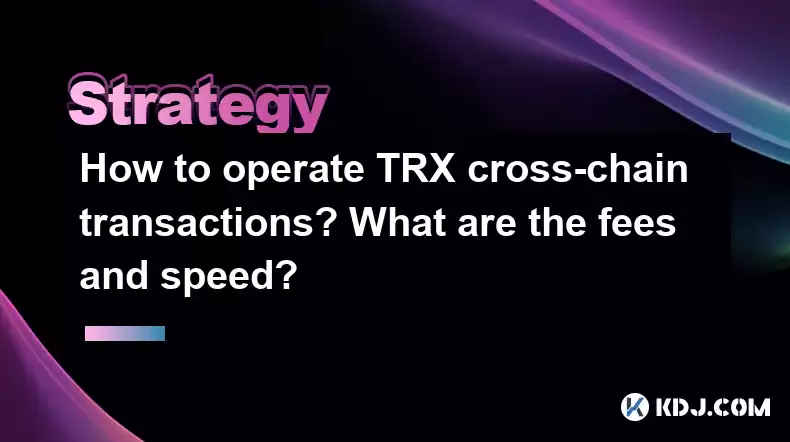-
 bitcoin
bitcoin $111743.690167 USD
0.54% -
 ethereum
ethereum $3950.699791 USD
0.55% -
 tether
tether $1.000164 USD
-0.01% -
 xrp
xrp $2.611685 USD
2.58% -
 bnb
bnb $1122.616845 USD
1.30% -
 solana
solana $193.462394 USD
-0.26% -
 usd-coin
usd-coin $0.999872 USD
-0.03% -
 dogecoin
dogecoin $0.196092 USD
-1.61% -
 tron
tron $0.296693 USD
-0.41% -
 cardano
cardano $0.652995 USD
-0.60% -
 hyperliquid
hyperliquid $44.316120 USD
12.98% -
 chainlink
chainlink $17.906269 USD
0.05% -
 ethena-usde
ethena-usde $0.999193 USD
-0.02% -
 stellar
stellar $0.326600 USD
1.70% -
 bitcoin-cash
bitcoin-cash $513.235984 USD
1.57%
How to operate TRX cross-chain transactions? What are the fees and speed?
TRX cross-chain transactions allow transferring tokens between TRON and other blockchains like Ethereum using platforms like Anyswap, with fees and speeds varying by network.
Apr 30, 2025 at 04:36 am

Cross-chain transactions have become a crucial aspect of the cryptocurrency ecosystem, enabling users to transfer assets between different blockchain networks seamlessly. TRX, the native cryptocurrency of the TRON blockchain, is no exception. In this article, we will explore how to operate TRX cross-chain transactions, delve into the associated fees, and discuss the speed of these transactions.
Understanding TRX Cross-Chain Transactions
Cross-chain transactions refer to the process of transferring assets from one blockchain to another. For TRX, this typically involves moving tokens from the TRON blockchain to another compatible blockchain, such as Ethereum or Binance Smart Chain. This process requires the use of a bridge or a decentralized exchange (DEX) that supports cross-chain swaps.
Choosing a Platform for TRX Cross-Chain Transactions
To initiate a TRX cross-chain transaction, you need to select a reliable platform. Some popular options include:
- Anyswap: A decentralized cross-chain swap protocol.
- JustSwap: TRON's own decentralized exchange that supports cross-chain swaps.
- Binance Bridge: A service provided by Binance that enables cross-chain transfers.
Each platform has its own set of features and user interfaces, so it's important to choose one that aligns with your needs and comfort level.
Step-by-Step Guide to Operating TRX Cross-Chain Transactions
Let's walk through the process of using Anyswap to perform a TRX cross-chain transaction from TRON to Ethereum:
- Connect Your Wallet: Navigate to the Anyswap website and connect your TRON wallet. This can be done using a wallet like TronLink or Math Wallet.
- Select the Tokens: Choose TRX as the token you want to transfer from the TRON network. Then, select the token you want to receive on the Ethereum network, such as ETH or a wrapped version of TRX (e.g., wTRX).
- Enter the Amount: Specify the amount of TRX you wish to transfer. Make sure to consider the fees associated with the transaction.
- Confirm the Transaction: Review the transaction details and confirm the transfer. You will need to sign the transaction using your TRON wallet.
- Wait for Confirmation: The transaction will be processed on the TRON network first. Once confirmed, it will be relayed to the Ethereum network, where it will need to be confirmed again.
- Receive Tokens on Ethereum: After both confirmations, you will receive the equivalent amount of tokens on the Ethereum network in your connected Ethereum wallet.
Fees Associated with TRX Cross-Chain Transactions
Transaction fees are an important consideration when conducting cross-chain transactions. The fees can vary depending on the platform and the networks involved. Here’s a breakdown of typical fees:
- Network Fees: These are the fees charged by the respective blockchains for processing the transaction. For TRON, the fee is relatively low, typically around 0.00001 TRX per transaction. On Ethereum, the fees can be more variable and depend on network congestion, often ranging from a few cents to several dollars.
- Bridge or DEX Fees: Platforms like Anyswap or JustSwap may charge a fee for facilitating the cross-chain swap. This fee is usually a percentage of the transaction amount, commonly ranging from 0.1% to 0.3%.
It's essential to check the current fee structure on the platform you are using before initiating a transaction.
Speed of TRX Cross-Chain Transactions
Transaction speed is another critical factor to consider. The speed of a TRX cross-chain transaction can vary based on several factors:
- TRON Network Confirmation: The first step involves confirming the transaction on the TRON network, which typically takes about 3 seconds due to TRON's fast block time.
- Cross-Chain Relay: After confirmation on TRON, the transaction data needs to be relayed to the destination network. This process can take anywhere from a few seconds to a few minutes, depending on the efficiency of the bridge or DEX.
- Destination Network Confirmation: Once relayed, the transaction needs to be confirmed on the destination network. For Ethereum, this can take anywhere from 15 seconds to several minutes, depending on network congestion.
Overall, a TRX cross-chain transaction can take anywhere from a few minutes to around 30 minutes, depending on the networks involved and current conditions.
Verifying and Troubleshooting TRX Cross-Chain Transactions
After initiating a TRX cross-chain transaction, it's important to verify that the transaction was successful. Here are some steps to follow:
- Check Transaction Status: Use the transaction ID provided by the platform to check the status on both the TRON and the destination network's block explorers (e.g., Tronscan for TRON, Etherscan for Ethereum).
- Monitor Your Wallets: Ensure that the tokens have been received in your destination wallet. If you do not see the tokens, double-check the wallet address and transaction details.
- Troubleshooting: If the transaction appears to be stuck or failed, contact the support team of the platform you used. They can provide guidance on resolving issues or recovering funds if necessary.
Frequently Asked Questions
Q: Can I reverse a TRX cross-chain transaction if I make a mistake?A: Generally, cross-chain transactions are irreversible once confirmed on both networks. It's crucial to double-check all transaction details before confirming. If you encounter issues, contact the platform's support team for assistance.
Q: Are there any risks associated with TRX cross-chain transactions?A: Yes, there are risks such as smart contract vulnerabilities, platform hacks, and network congestion. Always use reputable platforms and keep your private keys secure to mitigate these risks.
Q: Can I perform TRX cross-chain transactions using a hardware wallet?A: Yes, you can use a hardware wallet for TRX cross-chain transactions. Connect your hardware wallet to a compatible software wallet or directly to the platform's interface to initiate the transaction.
Q: Is there a limit to the amount of TRX I can transfer in a cross-chain transaction?A: The limits depend on the platform and the networks involved. Some platforms may have daily or per-transaction limits, so it's important to check these before initiating a large transfer.
Disclaimer:info@kdj.com
The information provided is not trading advice. kdj.com does not assume any responsibility for any investments made based on the information provided in this article. Cryptocurrencies are highly volatile and it is highly recommended that you invest with caution after thorough research!
If you believe that the content used on this website infringes your copyright, please contact us immediately (info@kdj.com) and we will delete it promptly.
- Essex Post Office, 5p Coins, and King Charles: A Royal Mint Revelation!
- 2025-10-23 10:30:16
- Waymo's Newark Airport AV Tests: Alphabet's AI Gamble Pays Off?
- 2025-10-23 10:30:16
- King Charles 5p Coins: A Royal Flush in Your Pocket?
- 2025-10-23 10:35:18
- Solana, Crypto Advisory, and Forward Industries: A New York Minute on the Future of Finance
- 2025-10-23 08:51:22
- MAGACOIN: Ethereum Whales Dive into the Hottest Presale of 2025
- 2025-10-23 08:51:22
- Kadena's End of the Road? KDA Token Plummets Amid Project Abandonment
- 2025-10-23 08:55:34
Related knowledge

A Simple Strategy for Scalping Ethereum (ETH) on the 5-Minute Chart
Oct 25,2025 at 01:54pm
A Simple Strategy for Scalping Ethereum (ETH) on the 5-Minute Chart This strategy focuses on short-term price movements of Ethereum using a 5-minute t...

A Guide to Trading Avalanche (AVAX) Perpetual Contracts for Beginners
Oct 25,2025 at 11:36pm
Understanding Avalanche (AVAX) Perpetual Contracts1. Perpetual contracts are a type of derivative product that allows traders to speculate on the pric...

How to Reduce Liquidation Risk on a High-Leverage BNB Position?
Oct 25,2025 at 05:36pm
Understanding Liquidation Mechanics in High-Leverage BNB Trading1. Liquidation occurs when the value of a leveraged position drops to a level where th...

How to Add Margin to Avoid Liquidation on Your XRP Futures Position?
Oct 26,2025 at 11:01am
Understanding Margin in XRP Futures Trading1. Margin acts as collateral when opening a leveraged futures position on XRP. It ensures that traders can ...

Practical parameter settings for a Bitcoin multi-timeframe moving average system
Sep 18,2025 at 10:54pm
Optimizing Timeframe Combinations for Bitcoin Trading1. Selecting appropriate timeframes is crucial when building a multi-timeframe moving average sys...

How can I filter out false breakouts in Dogecoin high-frequency trading?
Sep 22,2025 at 01:00am
Understanding False Breakouts in Dogecoin Trading1. A false breakout occurs when Dogecoin's price appears to move beyond a defined support or resistan...

A Simple Strategy for Scalping Ethereum (ETH) on the 5-Minute Chart
Oct 25,2025 at 01:54pm
A Simple Strategy for Scalping Ethereum (ETH) on the 5-Minute Chart This strategy focuses on short-term price movements of Ethereum using a 5-minute t...

A Guide to Trading Avalanche (AVAX) Perpetual Contracts for Beginners
Oct 25,2025 at 11:36pm
Understanding Avalanche (AVAX) Perpetual Contracts1. Perpetual contracts are a type of derivative product that allows traders to speculate on the pric...

How to Reduce Liquidation Risk on a High-Leverage BNB Position?
Oct 25,2025 at 05:36pm
Understanding Liquidation Mechanics in High-Leverage BNB Trading1. Liquidation occurs when the value of a leveraged position drops to a level where th...

How to Add Margin to Avoid Liquidation on Your XRP Futures Position?
Oct 26,2025 at 11:01am
Understanding Margin in XRP Futures Trading1. Margin acts as collateral when opening a leveraged futures position on XRP. It ensures that traders can ...

Practical parameter settings for a Bitcoin multi-timeframe moving average system
Sep 18,2025 at 10:54pm
Optimizing Timeframe Combinations for Bitcoin Trading1. Selecting appropriate timeframes is crucial when building a multi-timeframe moving average sys...

How can I filter out false breakouts in Dogecoin high-frequency trading?
Sep 22,2025 at 01:00am
Understanding False Breakouts in Dogecoin Trading1. A false breakout occurs when Dogecoin's price appears to move beyond a defined support or resistan...
See all articles










































































